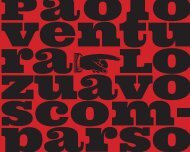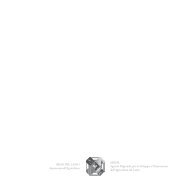Giuseppe Cavalli
Giuseppe Cavalli
Giuseppe Cavalli
- No tags were found...
You also want an ePaper? Increase the reach of your titles
YUMPU automatically turns print PDFs into web optimized ePapers that Google loves.
As Martin Harrison wrote in the introduction to the catalogue of the exhibition “<strong>Giuseppe</strong> <strong>Cavalli</strong> Photographs”<br />
held in London in June 2002, 1 <strong>Cavalli</strong> still has to be studied. Following this pronouncement from such an<br />
authority, and – I like to flatter myself – due also to the thrust provided by the <strong>Giuseppe</strong> <strong>Cavalli</strong> Archive, I have noticed<br />
that recent criticism has gone beyond certain interpretations that, frankly, were somewhat dated.<br />
I would like to quote Giuliana Scimè: “[<strong>Giuseppe</strong> <strong>Cavalli</strong>’s] images represent one of the most ground-breaking<br />
moments in Italian photography, and perhaps we are now in a position to understand his exceptional oeuvre.<br />
Accused in the past of ‘pure formalism’ by obdurate critics who favoured social issues, <strong>Cavalli</strong> is remarkably modern.”<br />
2 Scimè also writes: “<strong>Cavalli</strong> is truly the revolutionary creator of photography as an autonomous art in postwar<br />
Italy.” When discussing <strong>Cavalli</strong>’s still lifes, and particularly one of his most well-known ones, “Little ball”,<br />
Angela Madesani writes: “this ‘little ball’ placed on a low wall contains the history of Italian art: Renaissance<br />
geometries, plastic values, Morandi and the abstract atmospheres of Informel that was becoming established then.”<br />
Diego Mormorio speaks of “<strong>Cavalli</strong> and the pleasure of beauty ... one has the feeling – indeed, one is certain<br />
– that the Catholic <strong>Cavalli</strong> was perhaps closer to the pagan soul of the Ancient Greeks. He experienced the joy<br />
of seeing, and through seeing the joy of beauty and of art. <strong>Cavalli</strong> conveys this most clearly by quoting the De<br />
Goncourt brothers: ‘Apprendre à voir est le plus longue apprentissage de tous les arts’.” In his review of the exhibition<br />
organized by Museo di Roma - Palazzo Braschi, Luigi Silvi comments: “Through his brother Emanuele’s experiences<br />
<strong>Cavalli</strong> developed close contacts not only with Guidi, but also with other contemporaries... he developed<br />
the metaphysical experiments of Carrà, Rosai and also De Chirico, or possibly Savinio’s interpretation of Man Ray’s<br />
Surrealism. There was nothing of the formalist about <strong>Cavalli</strong>, who singled out from reality objects and images<br />
t h at he analyzed and used as the pre t ext for rep resenting lines, wh i t e s, bl a c k s, grey s, vo l u m e s, masses, spaces,<br />
light/nonlight, shadows, pale and dark tones, also establishing a dialogue with Mondrian’s Neoplastic works… his<br />
abstraction is almost a return to the Renaissance... swirling, wrinkled, rough surfaces, a prelude to matteric painting<br />
and still lifes, some partly reminiscent of Morandi and Carena and Metaphysical Art, others such as the rows of<br />
pots and of gloves, whose repetition sends signals across the Atlantic to the Pop artists... <strong>Cavalli</strong>’s intellectual experience<br />
is an adventure book, an explorer’s journal: a nomad ventures into new, unknown territories, seeking, investigating,<br />
experimenting, contaminating, opening up new paths and unexpected vistas.”<br />
I’d like to conclude these – perhaps lengthy – quotes with a poem written by Mario Giacomelli for the retrospective<br />
organized by the Senigallia Municipal Council in 1994:<br />
Daniele<br />
<strong>Cavalli</strong><br />
“Living in the future<br />
more than in the past.<br />
His style gave me<br />
the measure of his<br />
qualities, it was the itinerary<br />
of my soul, the means<br />
the nature, the power of inspiration.<br />
Now my feelings cannot find<br />
words worthy of Maestro <strong>Giuseppe</strong><br />
<strong>Cavalli</strong>, my respect<br />
for him is boundless” 7 .<br />
1 Martin Harrison, critical essay in the catalogue “<strong>Giuseppe</strong> <strong>Cavalli</strong> Photographs”, London, Faggionato Fine Arts – 49 albemarle street, 18/06-18/08/2002<br />
2 Giuliana Scimè in “Il Corrriere della Sera” 26/05/2004, review on the solo exhibition, Galleria San Fedele, Milano, 13/05-19/06/2004<br />
3 Giuliana Scimè in “Il Corriere della Sera” 9/12/2005, review for the exibition organized by “Fotografia Italiana”, Milano, 25/11/2005-21/01/2006<br />
4 Angela Madesani in “Diario” weekly magazine, n°5, 2006, pag.29, review on the solo exhibition, Museo di Roma – Palazzo Braschi, 8/04-31/05/2006<br />
5 Diego Mormorio, critical essay in “<strong>Giuseppe</strong> <strong>Cavalli</strong> fotografie 1936-1961”, critical essay in, catalogue of the solo exhibition, Museo di Roma – Palazzo Braschi,<br />
8/04-31/05/2006, pag.10<br />
6 Luigi Silvi in “Vespertilla”, Roman paper of cultural in deep exhibition, Febrary - March 2007, pag. 20<br />
7 In “<strong>Giuseppe</strong> <strong>Cavalli</strong> Tre Stagioni”, curated by Enzo Carli, catalogue of the retrospective organized by Senigallia Municipal Council – auditorium di San Rocco,<br />
23/07-16/08/1994<br />
208







